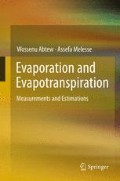Abstract
Climate change has been acknowledged as one of the greatest challenges for humanity. Although, there may be differences in opinions as to the cause of change, it is generally accepted that climate change is happening. There is sufficient data showing sea level rise and temperature rise and associated ecological changes. Climate change impacts on rainfall and evapotranspiration have not been conclusively determined. Decrease in rainfall and increase in temperature will result in increase in evapotranspiration. Global circulation models’ (GCMs) applications have shown spatially varying diverse trends for evapotranspiration. It is essential to put forth the effort to know the impact of climate change on evapotranspiration and use the information for developing adaptations in water use and water management.
Access this chapter
Tax calculation will be finalised at checkout
Purchases are for personal use only
References
Abtew W (1996) Evapotranspiration measurements and modeling for three wetland systems in south Florida. Water Resour Bull 32(3):465–473
Arnold JG, Srinivasan R, Muttiah RR, Williams JR (1998) Large area hydrologic modeling and assessment – Part I: model development. J Am Water Resour Assoc 34(1):73–89
Azam F, Farooq S (2005) Agriculture and global warming: evapotranspiration as an important factor compared to CO2. Pak J Biol Sci 8(11):1630–1638
Bates B, Kundzewicz ZW, Wu S, Palutokof J (2008) Climate change and water. IPCC technical paper VI. UNEP, Geneva
Calanca P, Roesch A, Jasper K, Wild M (2006) Global warming and the summertime evapotranspiration of the Alpine region. Clim Change 79(1–2):65–78
California Department of Water Resources (2006) Progress in incorporating climate change into management of California water resources. Technical Memorandum Report. California Department of Water Resources, Sacramento
Chattopadhyay N, Hulme M (1997) Evaporation and potential evapotranspiration in India under conditions of recent and future climate change. Agric For Meteorol 87(1):55–73
Cong Z, Yang D, Lei Z (2008) Did evaporation paradox disappear after the 1980s? A case study for China. Geophysical Research Abstracts. EGU, Munich, Germany
Dai A, Trenberth KE, Qian T (2004) A global dataset of Palmer drought index for 1870–2002: relationship with soil moisture and effects of surface warming. J Hydrometeorol 5(6):1117–1130
Goyal RK (2004) Sensitivity of evapotranspiration to global warming: a case study of arid zone of Rajasthan (India). Agric Water Manage 19(1):1–11
Hatfield J, Boote K, Fay P, Hahn L, Izaurralde C, Kimball BA, Mader T, Morgan J, Ort D, Polley W, Thomson A, Wolfe D (2008) Agriculture. In: Walsh M (ed) The effects of climate change on agriculture, land resources, water resources, and biodiversity. A Report by the U.S. Climate Change Science Program and the Subcommittee on Global Change Research, Washington, DC
International Panel on Climate Change (IPCC) (2007) Summary for policymakers. In: Climate change 2007: The physical science basis. Contribution of working group I to the fourth assessment report of the intergovernmental panel on climate change. In: Solomon S, Qin D, Manning M, Chen Z, Marquis M, Averyt KB, Tignor M, Miller HL (eds) Cambridge University Press, Cambridge, United Kingdom
Jung M et al (2010) Recent decline in the global evapotranspiration trend due to limited moisture supply. Nature 467:951–954
Melesse A, Setegn S, McClain M, Vicioso F, Veloz F, Fu J, Webber D, Ortiz J, Nunez F (2011) Caribbean coastal scenarios project, fifth year final report submitted to IAI under the agreement CRN II-061. Department of Environmental Studies, Florida International University, Miami, FL, May 2011, p 104
Obeysekera J, Park J, Ortiz MI, Trimble P, Barnes J, VanArman J, Said W, Gadzinski E (2011) Past and projected trends in climate and sea level for south Florida. Technical report. South Florida Water Management District, West Palm Beach, FL
Parry ML, Canziani OF, Palutikof JP, van der Linden PJ, Hanson CE (ed) (2007) Climate change 2007: impacts, adaptation and vulnerability. Contribution of working group II to the fourth assessment report of the intergovernmental panel on climate change (IPCC AR4 WG2 (2007). Cambridge University Press, Cambridge. ISBN 978-0-521-88010-7 (pb: 978-0-521-70597-4)
Twilley RR, Barron EJ, Gholz HL, Harwell MA, Miller RL, Reed DJ, Rose JB, Siemann EH, Wetzel RG, Zimmerman RJ (2001) Confronting climate change in the Gulf Coast Region. A report of the Union of Concerned Scientists and the Ecological Society of America. http://www.ucsusa.org/assets/documents/global_warming/gulfcoast.pdf. Accessed 6 Aug 2012
Vehviläinen B, Huttunen M (1997) Climate change and water resources in Finland. Boreal Environ Res 2:3–16
Zhang M, Geng S, Ransom M, Ustin S (1996) The effects of global warming on evapotranspiration and alfalfa production in California. Department of Land, Air and Water Resources, University of California, Davis
Author information
Authors and Affiliations
Corresponding author
Rights and permissions
Copyright information
© 2013 Springer Science+Business Media Dordrecht
About this chapter
Cite this chapter
Abtew, W., Melesse, A. (2013). Climate Change and Evapotranspiration. In: Evaporation and Evapotranspiration. Springer, Dordrecht. https://doi.org/10.1007/978-94-007-4737-1_13
Download citation
DOI: https://doi.org/10.1007/978-94-007-4737-1_13
Published:
Publisher Name: Springer, Dordrecht
Print ISBN: 978-94-007-4736-4
Online ISBN: 978-94-007-4737-1
eBook Packages: Earth and Environmental ScienceEarth and Environmental Science (R0)

